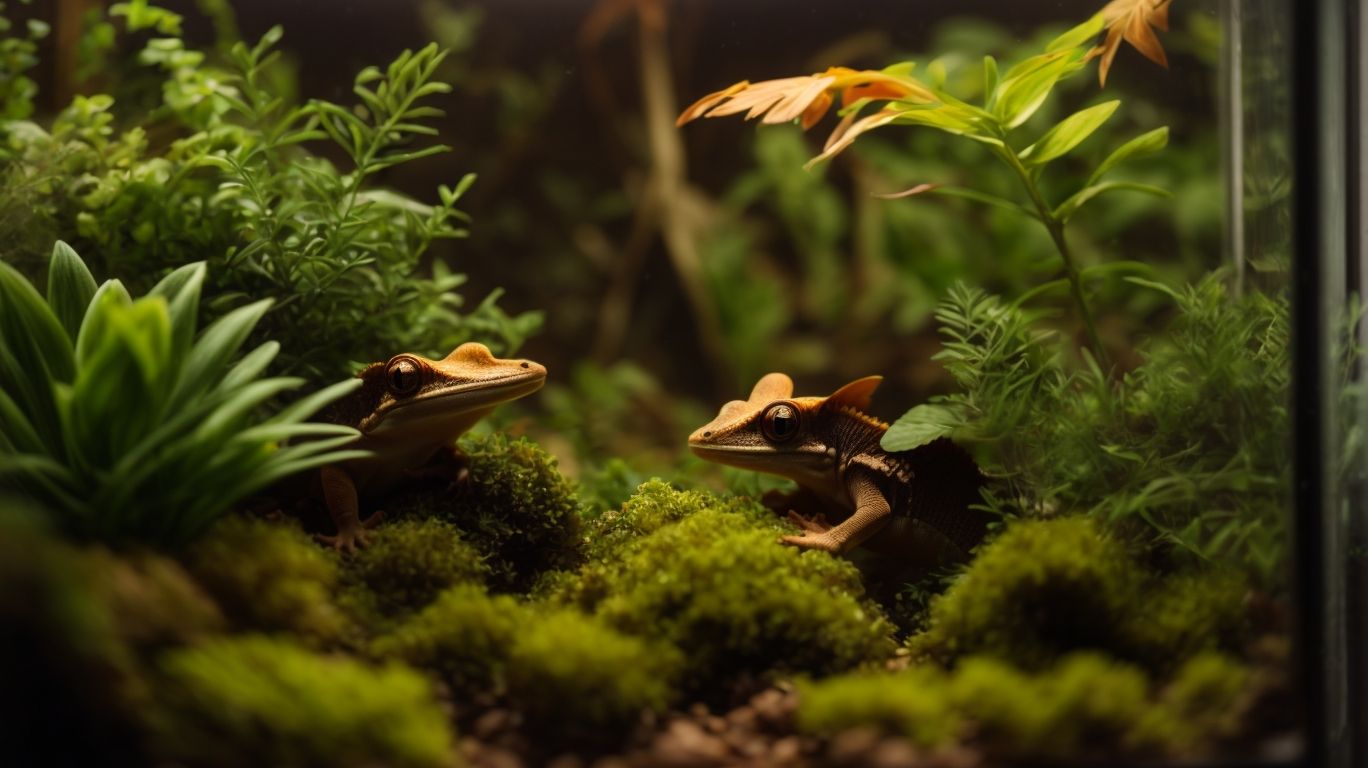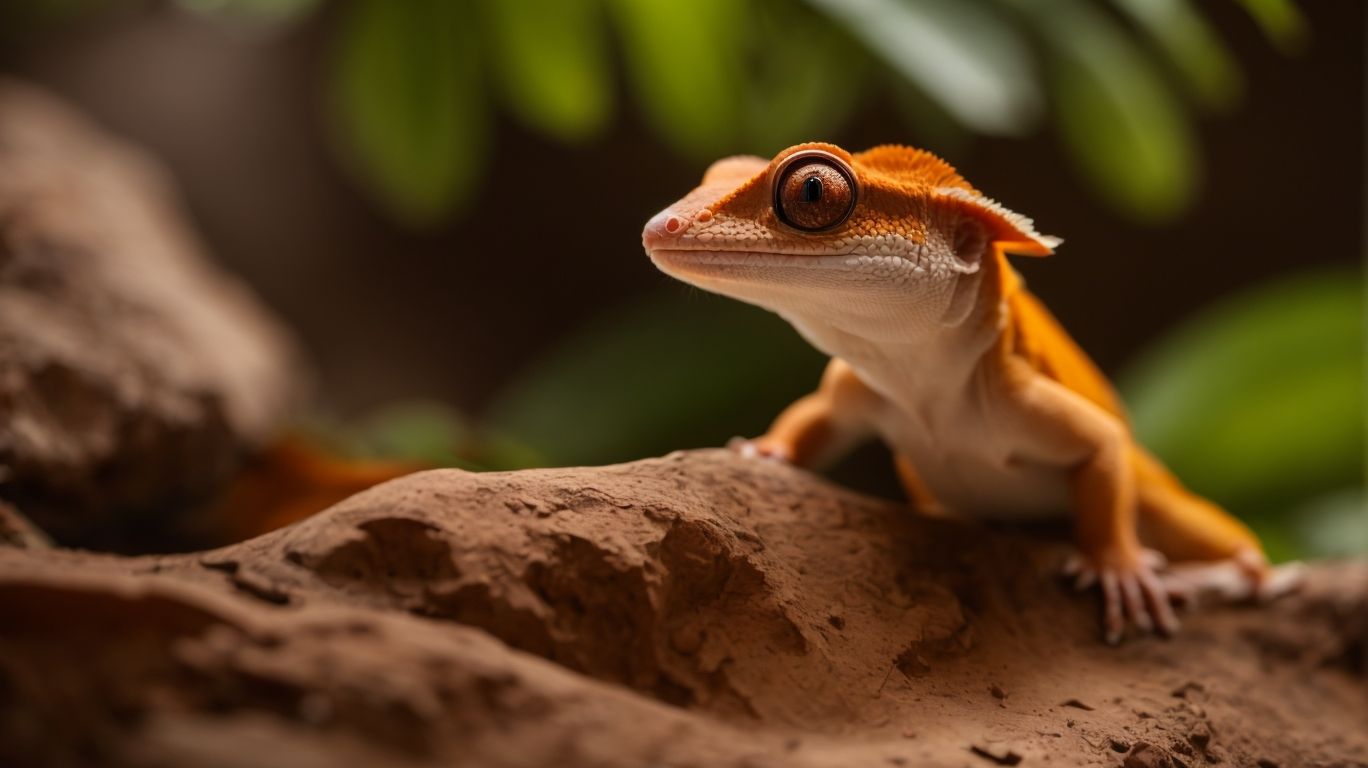
Best Woods and Plants for Your Crested Gecko’s Terrarium: Aesthetic and Functional Choices
Are you looking to create the perfect home for your crested gecko? Choosing the right wood and plants for their terrarium is crucial for both aesthetic and functional reasons.
In this article, we will explore the best types of wood and plants that are safe for your gecko, as well as the aesthetic considerations to keep in mind. Whether you’re aiming for a natural look, providing climbing opportunities, or creating hiding spots, we’ve got you covered.
Stay tuned to learn how to create a functional and beautiful terrarium for your beloved pet.
What Is a Crested Gecko’s Terrarium?
A Crested Gecko’s terrarium is a specially designed enclosure that simulates the natural habitat of this arboreal species, providing an ecosystem for environmental enrichment and well-being.
A gecko’s terrarium typically includes live plants, branches, and rocks to mimic their tropical forest environment. Temperature and humidity levels are carefully regulated to mirror their native climate, promoting healthy behavior and physiological functions. The terrarium also incorporates hiding spots and climbing structures to support the gecko’s natural instincts for exploration and physical activity. Additionally, proper substrate and a suitable water source contribute to creating a balanced and sustainable ecosystem within the terrarium.
Why Is Choosing the Right Wood and Plants Important for a Crested Gecko’s Terrarium?
Choosing the right wood and plants for a Crested Gecko’s terrarium is crucial as it impacts the functionality and aesthetic appeal of the reptile habitat. This careful selection contributes to the overall well-being and naturalistic environment for the gecko.
This careful selection of wood and plants also plays a significant role in supporting environmental enrichment within the gecko’s habitat. By mimicking the natural environment of the crested gecko, suitable wood and plants provide opportunities for the gecko to exhibit natural behaviors, explore its surroundings, and find hiding spots. This promotes physical and mental stimulation for the gecko.
The presence of live plants helps in maintaining humidity levels, improving air quality, and creating a dynamic living space for the gecko.
What Types of Wood Are Safe for a Crested Gecko’s Terrarium?
When considering wood for a Crested Gecko’s terrarium, it’s essential to prioritize safe and suitable options such as cork bark, Mopani wood, grapevine wood, and Manzanita wood. These materials provide climbing opportunities, hiding spots, and a natural aesthetic for your gecko.
Cork bark is ideal for its light weight and natural look, offering the gecko a textured surface to explore and climb.
Mopani wood, with its characteristic dark and light tones, not only provides visual appeal but also serves as a durable and long-lasting decoration.
Grapevine wood‘s meandering and twisted forms create an intriguing environment for the gecko to navigate, and its varying thicknesses offer diverse climbing possibilities.
Manzanita wood, known for its intricate shapes and smooth texture, enhances the terrarium’s natural look while providing sturdy branches for the gecko to perch and exercise on.
Cork Bark
Cork bark is a popular choice for Crested Gecko terrariums, offering a natural look and providing ample climbing opportunities and hiding spots for the gecko.
The cork bark used in Crested Gecko terrariums adds a visually appealing, naturalistic element with its earthy tones and textured surface. It also serves a practical purpose by encouraging the gecko’s natural climbing behavior and providing exercise and exploration opportunities. Additionally, cork bark is lightweight and easy to manipulate, making it ideal for creating terrarium arrangements that mimic the gecko’s natural habitat and promote overall well-being.
Mopani Wood
Mopani wood is a suitable choice for Crested Gecko terrariums, known for its aesthetic appeal, durability, and ability to create climbing opportunities and hiding spots within the enclosure.
This type of wood, with its unique texture and natural patterns, adds a touch of wilderness to the terrarium, enhancing the visual appeal while providing a sturdy structure for geckos to climb and explore.
The durable nature of Mopani wood ensures that it withstands the wear and tear of a gecko’s active lifestyle, making it a practical and long-lasting choice for terrarium decor. Its irregular shapes and crevices also serve as perfect hiding spots, allowing geckos to feel secure and exhibit natural behavior in their habitat.
Grapevine Wood
Grapevine wood is a favored option for Crested Gecko terrariums. Its naturalistic appearance, lightweight nature, and provision of climbing branches and hiding spots enhance the gecko’s habitat.
This wood not only mimics the gecko’s natural environment, but also provides an enriching and stimulating habitat.
Its intricate, twisted shapes create an interesting and varied terrain for the gecko to explore. This promotes natural behaviors such as climbing and foraging.
Due to its lightweight properties, grapevine wood is easy to rearrange and customize in the terrarium. This allows for regular environmental enrichment and prevents boredom for the gecko.
Manzanita Wood
Manzanita wood is a commendable choice for Crested Gecko terrariums, known for its aesthetic appeal, moisture resistance, and its ability to create climbing opportunities and hiding spots, promoting a naturalistic setup for the gecko.
This wood’s intricate and twisted shapes add visual interest to the terrarium, mimicking the gecko’s natural habitat. In addition to its visual appeal, Manzanita wood resists moisture, helping to maintain the optimal humidity levels needed for the gecko’s well-being.
Its sturdy branches offer ideal surfaces for the gecko to climb and explore, enhancing their physical activity and mental stimulation. This wood contributes significantly to creating an enriching and comfortable environment for the Crested Gecko.
What Types of Plants Are Safe for a Crested Gecko’s Terrarium?
In a Crested Gecko’s terrarium, it’s essential to include safe plant options such as Pothos, Bromeliads, Spider Plants, and Philodendron. These plants not only add a touch of greenery, but also provide hiding spots and enhance the aesthetic appeal of the terrarium.
Adding live plants to a terrarium has multiple benefits. Live plants help maintain proper humidity levels for geckos, creating a more natural and enriching environment for them to live in. They also contribute to a more dynamic ecosystem within the terrarium, promoting a healthier and more engaging habitat for geckos to thrive in. This enhances their overall well-being and quality of life.
Pothos
Pothos is an ideal plant for Crested Gecko terrariums, offering abundant foliage, climbing opportunities, and hiding spots, enhancing the visual appeal and naturalistic environment for the gecko.
This versatile plant not only adds a lush greenery to the terrarium, but its trailing vines provide the gecko with ample climbing branches, mimicking its natural habitat.
The dense foliage also creates secluded areas for the gecko to seek privacy and security, reducing stress. The addition of Pothos not only benefits the gecko’s physical and mental wellbeing but also elevates the aesthetic appeal of the terrarium, making it a win-win choice for both the owner and the gecko.
Bromeliads
Bromeliads are excellent additions to Crested Gecko terrariums, creating a tropical environment, regulating humidity levels, and providing both aesthetic and functional benefits to the gecko’s habitat.
Geckos thrive in a natural tropical environment, which is why it’s important to mimic this in their terrarium. One way to do this is by incorporating live plants. These plants not only provide a sense of familiarity and comfort for the gecko, but also help regulate humidity and create a healthy microclimate.
In addition to their functional benefits, live plants also add visual appeal to the habitat. Their vibrant foliage and unique shapes make for a more visually interesting environment. Plus, they offer hiding spots and climbing surfaces for the gecko, serving both practical and aesthetic purposes.
Spider Plants
Spider plants are beneficial for Crested Gecko terrariums, imparting a natural look, contributing to environmental enrichment, and providing a visually appealing and functional addition to the gecko’s habitat.
Spider plants are a great addition to any gecko terrarium. Not only do they create a lush and vibrant atmosphere, but they also mimic the gecko’s natural habitat in the wild. Their dangling leaves and cascading vines provide climbing opportunities for the gecko, promoting physical exercise and mental stimulation.
These plants thrive in high humidity, making them perfect for regulating the terrarium’s moisture levels. This creates a healthy microclimate for the gecko to thrive in. Additionally, spider plants enhance the aesthetics and ecosystem balance of the gecko’s living space, making it both visually pleasing and enriching.
Philodendron
Philodendron plants are safe and aesthetically pleasing options for Crested Gecko terrariums, providing a lush greenery, while ensuring a safe and visually appealing environment for the gecko.
These tropical plants not only add a touch of natural beauty to the terrarium but also offer a safe and comfortable habitat for your pet.
The broad leaves of the Philodendron provide ample hiding spots for your Crested Gecko and contribute to creating a visually pleasing and enriching environment.
The low-maintenance nature of Philodendrons makes them ideal for beginner reptile owners, as they thrive in the warm and humid conditions typically found in Crested Gecko terrariums.
What Are the Aesthetic Considerations for Choosing Wood and Plants for a Crested Gecko’s Terrarium?
When selecting wood and plants for a Crested Gecko’s terrarium, it’s important to consider the natural look, provide climbing opportunities, and ensure ample hiding spots, creating an aesthetically pleasing and environmentally enriching habitat.
Incorporating natural-looking wood and plants not only enhances the visual appeal of the terrarium but also contributes to the functionality of the habitat.
The wood can mimic the gecko’s natural environment, offering them places to climb, perch, and explore. Strategically placed plants can serve as hiding spots, creating a sense of security for the gecko while adding to the overall aesthetic of the setup.
By carefully selecting and arranging these elements, you can create a naturalistic and visually appealing environment for your Crested Gecko.
Natural Look
Creating a natural look in a Crested Gecko’s terrarium involves incorporating live plants, organic materials, and suitable wood options to mimic the gecko’s native habitat, promoting a visually appealing and biodegradable environment.
Integrating tropical plant species like Pothos, Ficus, and Orchids into the terrarium can create a flourishing environment with lush foliage, adding a sense of authenticity.
Organic materials such as coconut husk substrate and cork bark not only enhance the natural aesthetic but also provide a sustainable habitat for the gecko. Additionally, choosing driftwood or Mopani wood can serve as climbing structures and perches for the gecko, mimicking its natural surroundings. These eco-friendly options not only improve the terrarium’s appearance but also contribute to the gecko’s well-being.
Climbing Opportunities
Providing ample climbing opportunities in a Crested Gecko’s terrarium is essential, especially for this arboreal species, as it promotes environmental enrichment and supports the gecko’s natural instincts and physical activity.
This type of enrichment is crucial to mimic the gecko’s native habitat, which typically includes trees and branches where they can climb and explore.
By integrating these climbing structures, gecko owners can observe their pets engaging in natural behaviors, such as hunting for food or seeking shelter. This not only benefits their overall well-being but also creates a more engaging and dynamic environment within the terrarium.
Hiding Spots
Incorporating hiding spots in a Crested Gecko’s terrarium is crucial for providing a secure and stress-free environment. This ensures the gecko’s well-being and promotes its sense of security within the habitat.
These hiding spots mimic the natural environment of the gecko, allowing it to exhibit its instinctual behaviors such as hiding and seeking shelter. When offered functional choices in their habitat, Crested Geckos experience less stress, leading to better overall health.
Providing various hiding spots also creates a dynamic and interactive environment for the gecko, allowing it to explore and find optimal spots for comfort and safety.
How Can You Create a Functional and Aesthetic Terrarium for Your Crested Gecko?
Creating a functional and aesthetic terrarium for your Crested Gecko involves layering substrate, incorporating natural decor, mixing and matching wood and plants, and adding decorative elements to enhance the overall habitat.
Layering substrate is vital for facilitating drainage and providing a suitable foundation for your gecko’s natural behaviors.
Begin with a base layer of drainage material such as gravel, followed by a layer of activated charcoal to reduce odors and toxins. The next layer should consist of a quality substrate, such as coconut coir or organic soil, to support plant growth and mimic the gecko’s natural environment.
When selecting natural decor, prioritize options like driftwood, vines, and live plants to create a visually stimulating and enriching habitat. Integrating decorative elements like moss, cork bark, and artificial plants can further elevate the terrarium’s visual appeal while providing your gecko with interactive elements to explore.
Layering Substrate
Layering substrate in a Crested Gecko’s terrarium is essential, as it provides an eco-friendly, moisture-retentive, and safe foundation for the gecko’s habitat, promoting a naturalistic and sustainable environment.
This layering process typically involves using a combination of materials such as coconut fiber, sphagnum moss, and organic topsoil to create a well-rounded substrate composition. This blend not only aids in maintaining appropriate humidity levels but also supports natural behaviors like digging and burrowing.
The eco-friendly nature of this sustainable choice reduces the environmental impact, while the substrate’s ability to hold moisture contributes to a more stable and comfortable living space for the Crested Gecko.
Mixing and Matching Wood and Plants
Mixing and matching wood and plants in a Crested Gecko’s terrarium allows for the creation of an aesthetically pleasing and functional habitat. This provides diverse visual elements and functional choices for the gecko.
The combination of natural wood features, such as driftwood and vines, with live plants like pothos and bromeliads, not only adds a striking visual appeal but also offers climbing opportunities and hiding spots for the gecko.
The presence of live plants contributes to the terrarium’s ecosystem by regulating humidity levels, oxygenating the air, and providing a sense of natural enrichment for the gecko. This mix of wood and plants creates a dynamic and captivating environment that closely mimics the gecko’s natural habitat, promoting its overall well-being and health.
Adding Decorative Elements
Incorporating decorative elements in a Crested Gecko’s terrarium is beneficial for environmental enrichment and the reptile’s well-being, as long as the elements are safe, visually appealing, and contribute to the gecko’s habitat.
These decorative elements serve a dual purpose, providing not only aesthetic value but also opportunities for physical activity. The placement of climbing branches and ledges encourages the gecko’s natural instincts, promoting exercise and mental stimulation.
Carefully selected foliage and hideouts offer security and privacy, reducing stress and enhancing the overall living environment. It’s crucial to choose reptile-safe materials such as natural wood, non-toxic plants, and stable structures to ensure the gecko’s safety and well-being. By creating a dynamic and engaging habitat, keepers can support their Crested Gecko’s natural behaviors and overall health.
Regular Maintenance and Replacements
Regular maintenance and periodic replacements are essential for ensuring a sustainable, low-maintenance, and safe environment within a Crested Gecko’s terrarium. This promotes the well-being and longevity of the gecko’s habitat.
Regularly inspecting and cleaning your terrarium is crucial in preventing the build-up of harmful bacteria and mold. This ensures a healthy and hygienic living space for your gecko.
Incorporating eco-friendly and durable materials in the terrarium setup not only reduces the need for frequent replacements, but also promotes long-term sustainability. This creates a harmonious and enriching habitat for your pet.
By taking a proactive approach to habitat upkeep, you are fostering a thriving ecosystem while minimizing the environmental impact. This aligns with making eco-conscious choices for the well-being of your gecko and the planet.




No Comments